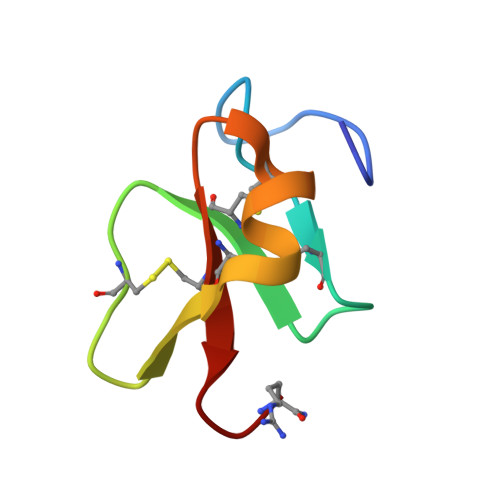The Ancestral N-Terminal Domain of Big Defensins Drives Bacterially Triggered Assembly into Antimicrobial Nanonets.
Loth, K., Vergnes, A., Barreto, C., Voisin, S.N., Meudal, H., Da Silva, J., Bressan, A., Belmadi, N., Bachere, E., Aucagne, V., Cazevielle, C., Marchandin, H., Rosa, R.D., Bulet, P., Touqui, L., Delmas, A.F., Destoumieux-Garzon, D.(2019) mBio 10
- PubMed: 31641083
- DOI: https://doi.org/10.1128/mBio.01821-19
- Primary Citation of Related Structures:
6QBK, 6QBL - PubMed Abstract:
Big defensins, ancestors of β-defensins, are composed of a β-defensin-like C-terminal domain and a globular hydrophobic ancestral N-terminal domain. This unique structure is found in a limited number of phylogenetically distant species, including mollusks, ancestral chelicerates, and early-branching cephalochordates, mostly living in marine environments. One puzzling evolutionary issue concerns the advantage for these species of having maintained a hydrophobic domain lost during evolution toward β-defensins. Using native ligation chemistry, we produced the oyster Crassostrea gigas BigDef1 ( Cg- BigDef1) and its separate domains. Cg- BigDef1 showed salt-stable and broad-range bactericidal activity, including against multidrug-resistant human clinical isolates of Staphylococcus aureus We found that the ancestral N-terminal domain confers salt-stable antimicrobial activity to the β-defensin-like domain, which is otherwise inactive. Moreover, upon contact with bacteria, the N-terminal domain drives Cg- BigDef1 assembly into nanonets that entrap and kill bacteria. We speculate that the hydrophobic N-terminal domain of big defensins has been retained in marine phyla to confer salt-stable interactions with bacterial membranes in environments where electrostatic interactions are impaired. Those remarkable properties open the way to future drug developments when physiological salt concentrations inhibit the antimicrobial activity of vertebrate β-defensins. IMPORTANCE β-Defensins are host defense peptides controlling infections in species ranging from humans to invertebrates. However, the antimicrobial activity of most human β-defensins is impaired at physiological salt concentrations. We explored the properties of big defensins, the β-defensin ancestors, which have been conserved in a number of marine organisms, mainly mollusks. By focusing on a big defensin from oyster ( Cg- BigDef1), we showed that the N-terminal domain lost during evolution toward β-defensins confers bactericidal activity to Cg- BigDef1, even at high salt concentrations. Cg- BigDef1 killed multidrug-resistant human clinical isolates of Staphylococcus aureus Moreover, the ancestral N-terminal domain drove the assembly of the big defensin into nanonets in which bacteria are entrapped and killed. This discovery may explain why the ancestral N-terminal domain has been maintained in diverse marine phyla and creates a new path of discovery to design β-defensin derivatives active at physiological and high salt concentrations.
Organizational Affiliation:
Centre de Biophysique Moléculaire UPR4301 CNRS, Orléans, France.















